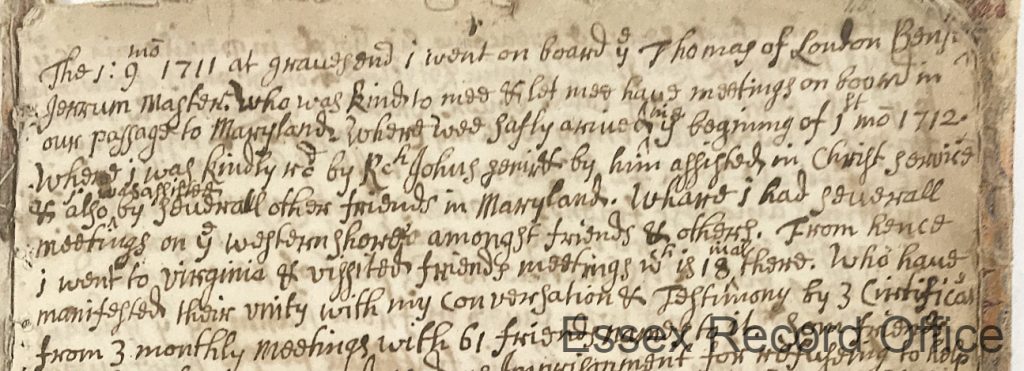
Julie Miller, a masters student from University of Essex, has taken up a research placement at the Essex Record Office, conducting an exploration into the story of John Farmer and his adventures, particularly in pre-revolutionary America, and has been jointly funded by the Friends of Historic Essex and University of Essex. Julie will be publishing a series of updates from the 12-week project.
In this installment we will look at some of the encounters John Farmer had in pre-revolutionary America.
Having returned to Essex in England from his Irish adventures in May 1711, and not being one to stay in a place for long, by Autumn 1711 John Farmer was off on his travels again. Before travelling John Farmer’s wife Mary, step daughter Mary Fulbigg and 10-year-old daughter Ann moved from Colchester where they had settled in 1708, back to Saffron Walden. John explained further in his journal:
“I staid at home a little with my wife & helped hur to remove to Saffron Walden. For shee thought it best for hur in my absence to bee there amongst hur relations with hur lame daughter whom she hoped there to help in to busness whereby shee might git hur a living: which shee could not doo at Colchester. But Colchester is ye best place of ye 2 for my wifes nursing & my woolcoming. Whereby wee earned good wages there untill my wife was taken from it by hur daughters sickness & I was taken from it by ye Lords sending mee to Ireland as aforesaid”.[i]

After putting his affairs in order John Farmer set off from Gravesend on 1st November 1711 on a ship called the Thomas of London, captained by Master Benjamin Jerrum. The voyage was uneventful, and John Farmer was allowed to hold meetings on board and landed in Maryland at the beginning of March 1711/12 having spent 4 months at sea. Having been met of the ship by well-known Quaker Richard Johns Senior, John Farmer stayed with Mr Johns at his house ‘Clifts’, in Calvert County while he travelled within Maryland, and held several meetings along the Western Shore before travelling on to Virginia where he held a further eighteen meetings.
In Virginia Farmer was troubled by reports that local Quakers had been imprisoned for refusing to help build garrisons or fortifications. This reluctance was due to a key principle of the Quaker movement, the Peace Testimony declared by founder George Fox in 1660, which was a vow of pacifism that endures to this day.[ii] Quakers refused to have any part in building fortifications and rejected all weapons of war. Farmer recounted stories of the harm done by the local Native American people to settlers who had been persuaded to take up arms, and the Quakers saved by tribespeople when they held no weapons:
“For I have been cridditably Informed yt som friends hereaway for severall years (in obedience to Christ) have refused to make use of Garrisons & carnall weapons for their defence against Indians: & have Insteed thereof made use of faith in God & prayer to God: & hee hath saved them from beeing destroyed by Indians …who did destroy their neighbours who did use weapons, particularly one man whom his neighbours perswaded to carry a gun, but the Indians seeing him with a gun shot him deadly and they afterwards said that it was his carrying a gun that caused them to kill him which otherwise they would not have done.”
Moving on to North Carolina John Farmer was troubled to hear of a recent massacre 20 miles away and reported in his journal that he heard a Quaker had forcibly taken land from the local native Americans, “whereas hee might have bought his land for an iron pottage pot.”

Native American communities had suffered considerably at the hands of the new settlers who raided the villages and kidnapped the people to be sold into slavery and stole land. The tribes had also suffered substantial population decline after exposure to the infectious diseases endemic to Europeans. As a result, under the leadership of Chief Hancock, the southern Tuscarora allied with the Pamlico, the Cothechney, Coree, Woccon, Mattamuskeet and other tribes to attack the settlers in a series of coordinated strikes that took place in Bath County, North Carolina on 22nd September 1711 and which heralded the start of the Tuscarora War that lasted until 1715. [iii]
John Farmer described the suffering of that Quaker family in the Bath County Massacre though it is clear where he felt the fault lay.
“These Indians haveing been much wronged by English French & pallitins did at last come sudenly upon ym & kiled & took prisoners, as i was told 170 of them & plundered & burnt their houses. Amongst the rest ye said Friend was kiled as he lay sick in his bedd & his wife & 2 young children wer caried away captive & Induered much hardship. But upon a peace made with ye Indians they were delivered & returned to Pensilvania.” [iv]
Travelling back to Virginia and then Maryland John Farmer attended the 1711 Yearly Meeting at West River on the Western Shore of Maryland but there he contracted ‘ague & feavor’ which made him too ill to travel for four weeks and began what he called a “sickly time for mee and others”. This was almost certainly Malaria which was endemic at the time. Eventually he recovered, and travelled on to New York, Rhode Island and Nantucket Island before arriving in Dover, New England. He was not specific about the date, but it was sometime in 1712. Farmer recorded that he held many meetings amongst Friends and others “notwithstanding the danger from the Indian Wars which had long been destructive in this part of New England.”[v]
In the winter of 1712 Farmer was in Rhode Island where he nearly died after being injured in a fall from his horse. But by May 1713 he was recovered enough to attend meetings at Long Island, East and West Jersey and back to Maryland where he spent some time working at wool combing again, presumably to increase his depleted funds.
It was here that “I received fresh orders from Christ to have meetings amongst Indians in order to their conversation to Christ and to go to Virginia and Pensilvania and the West Indies in his service”.[vi] And thus the next year’s travel was planned.
And that is where we can leave
John Farmer, planning his first expedition to take the Quaker message to the Native
American people. And those encounters
will make up the content of the next article.
[i] John Farmer Journal, Essex Record Office A13685, Box 51, p.44
[ii] To George Fox, this principle served a two-fold purpose, as a protest against the horrors of the English Civil Wars, and to try to mitigate the opportunity for violence to be done to Quakers, if they were perceived as peaceful, if rather disruptive, themselves. For more information see M Rediker, The Fearless Benjamin Lay, 2017, Verso, London Ch 1, p.19
[iii] The Tuscarora War was fought in North Carolina from September 1711 until February 1715 between the British, Dutch, and German settlers and the Tuscarora Native Americans. The Europeans enlisted the Yamasee and Cherokee as Indian allies against the Tuscarora, who had amassed several allies themselves. Principal targets were the planters along the Roanoke, Neuse, and Trent rivers and the city of Bath. They mounted their first attacks on 22nd September 1711 and killed hundreds of settlers. One witness, a prisoner of the Tuscarora, recounted stories of women impaled on stakes, more than 80 infants slaughtered, and more than 130 settlers killed. The militia and approximately 500 Yamasee marched into Tuscarora territory and killed nearly 800, and after a second assault on the main village, King Hancock, the Tuscarora chief, signed a treaty. After a treaty violation by the English, war erupted again. The militia and about 1,000 Indian allies travelled into Tuscarora territory. Approximately 400 Tuscarora were sold into slavery. The remaining Tuscarora fled northward and joined the Iroquois League as the Sixth Nation.
For more information about these events see
https://en.wikipedia.org/wiki/Tuscarora_War
https://northcarolinahistory.org/encyclopedia/tuscarora-war/
https://tuscaroranationnc.com/tribal-history
[iv] John Farmer Journal, Essex Record Office A13685, Box 51, p.46
[v] John Farmer Journal, Essex Record Office A13685, Box 51, p.47
[vi] John Farmer Journal, Essex Record Office A13685, Box 51, p.50
